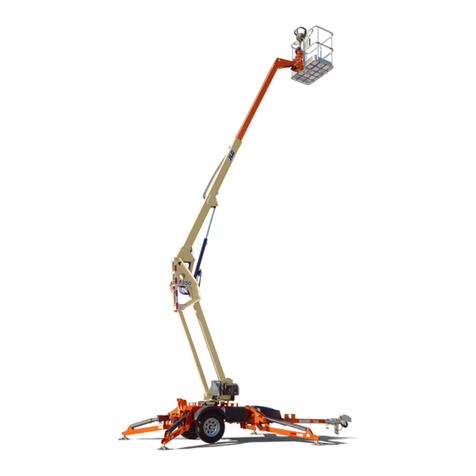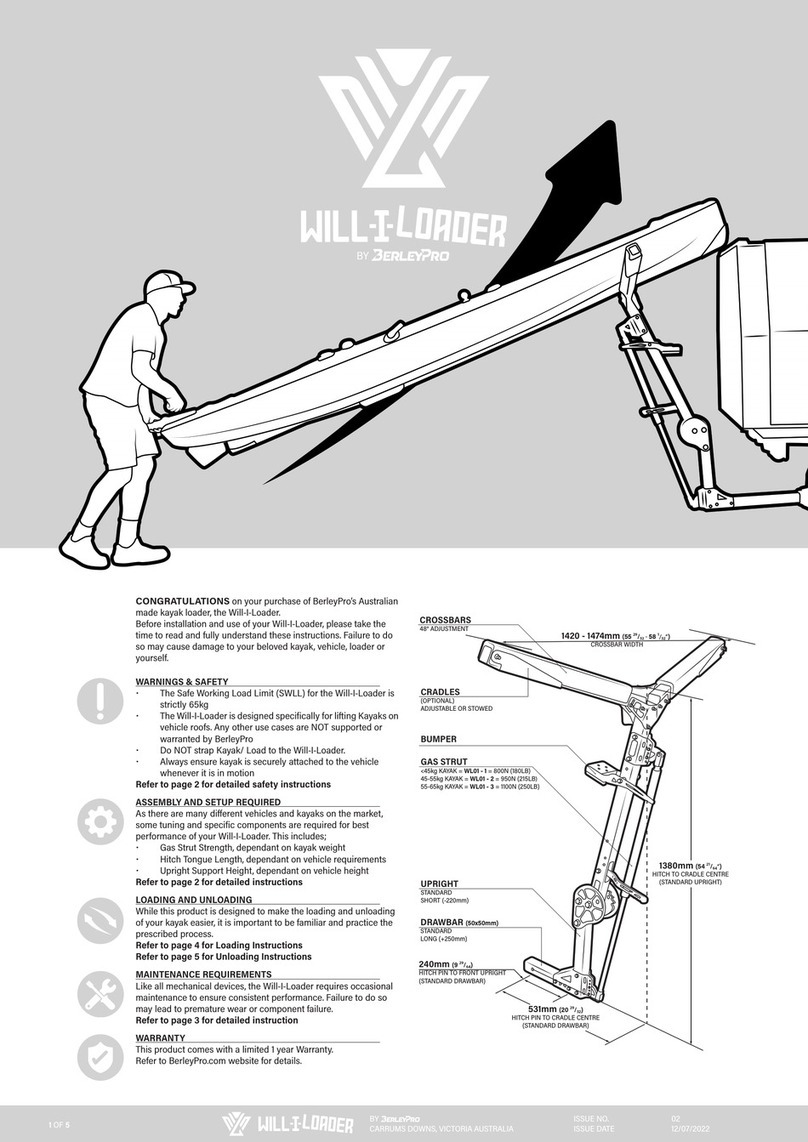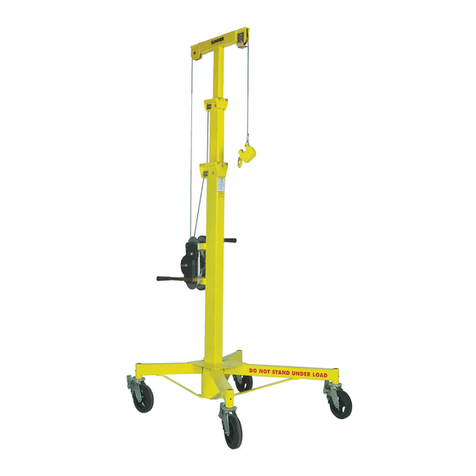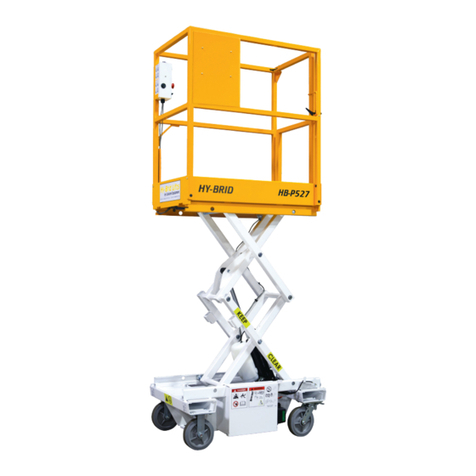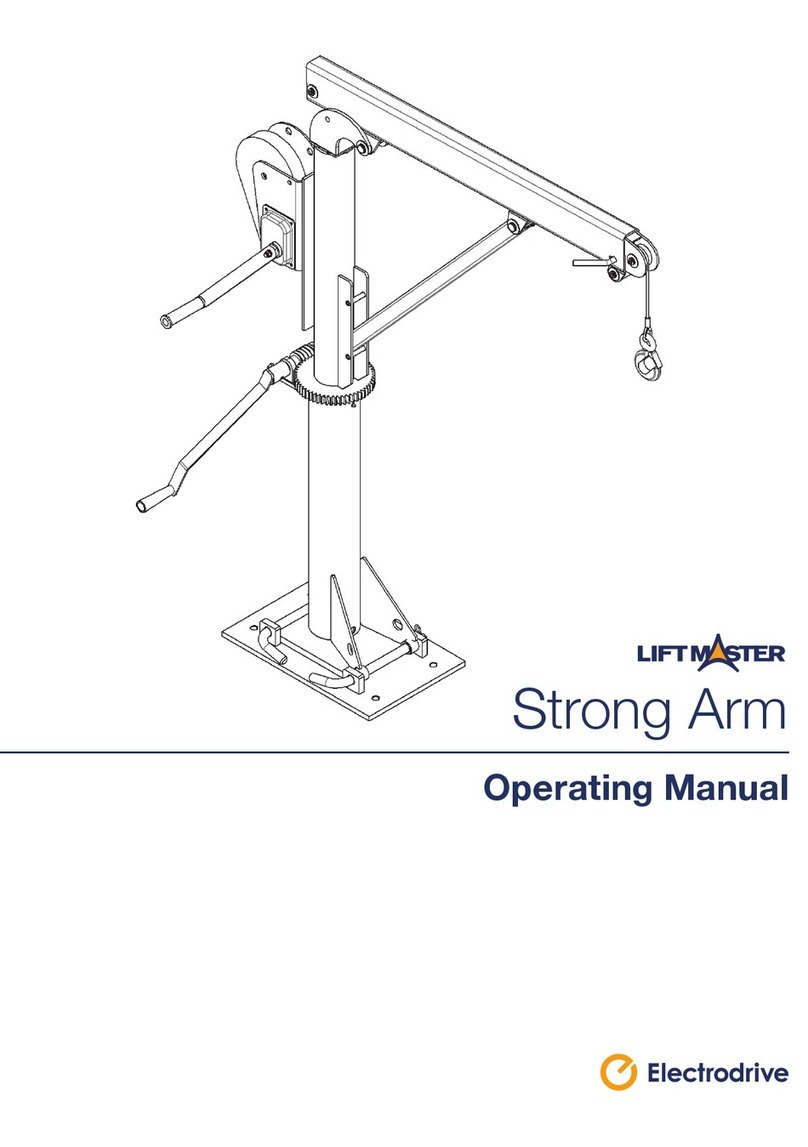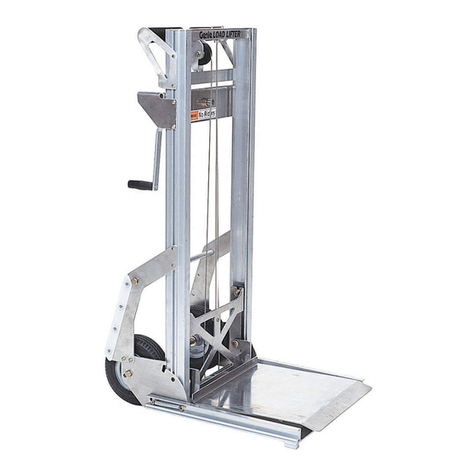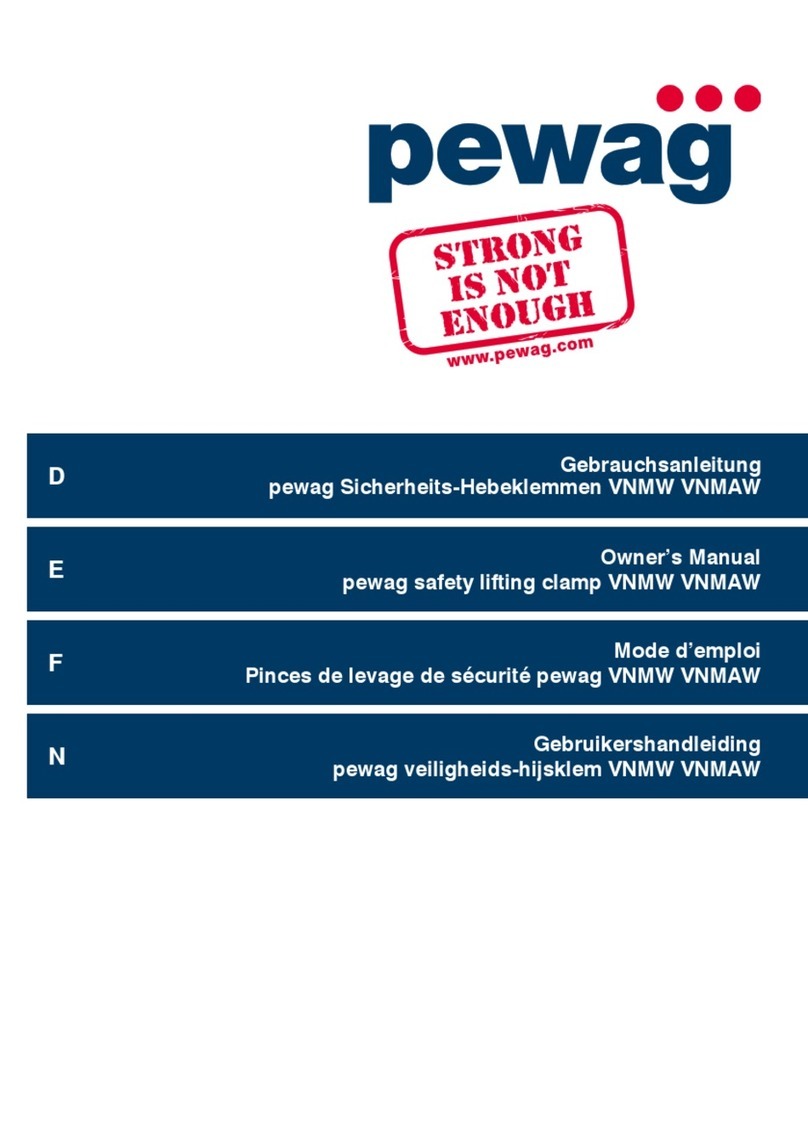GARO TFA4500-3D User manual

USER’S MANUAL
ELECTRO-HYDRAULIC
FOUR-POST LIFT
MODEL: TFA4500-3D
TFA5000-3D
TFA5500-3D
TFL5000-3D
Version: RR190604.01
Serial No.:
Production Date:


USER’S MANUAL
-i-
TABLE OF CONTENTS
Chapter 1 DESCRIPTION OF THE MACHINE................................................................................................................1
1.1 FIXED STRUCTURE ASSEMBLY.................................................................................................................................1
1.2 MOVABLE STRUCTURE................................................................................................................................................2
Chapter 2 SPECIFICATIONS............................................................................................................................................4
2.1 OVERALL DIMENSIONS ...............................................................................................................................................4
2.2 TECHNICAL SPECIFICATION………………………………………………………………………………………6
2.3 ELECTRIC MOTOR .........................................................................................................................................................6
2.4 HYDRAULIC PUMP.................................................................................................................................................6
2.5 OIL......................................................................................................................................................................................6
2.6 TYPES OF VEHICLES SUITABLE FOR BEING LIFTED AND OVERALL DIMENSIONS .....................................7
Chapter 3 SAFETY.................................................................................................................................................................8
Chapter 4 INSTALLATION................................................................................................................................................13
4.1 ASSEMBLY OF MOVABLE STRUCTURE (PLATFORM)........................................................................................14
4.2 POST ASSEMBLY...........................................................................................................................................................15
4.3 HYDRAULIC SYSTEM CONNECTION……...............................................................................................................17
4.4 ELECTRICAL SYSTEM CONNECTION....................................................................................................................17
4.5 CABLE PRE-ADJUSTMENT………………………………….................................................................................18
4.6 SECURE THE POSTS TO THE GROUND....................................................................................................................18
4.7 INSTALLING THE VEHICLE RAMPS AND THE WHEEL STOPS……………………………………………….19
4.8 ADJUSTING THE LIFTING CABLES………………………………………………………………………………19
4.9 PRELIMINARY TESTS AND INSPECTIONS BEFORE STARTING……………………………………………..20
Chapter 5 OPERATING PRINCIPLES AND USE .........................................................................................................21
Chapter 6 MAINTENANCE................................................................................................................................................22
Chapter 7 TROUBLESHOOTING.....................................................................................................................................25
APPENDIX A SPECIAL INFORMATION......................................................................................................................26
APPENDIX B HYDRAULIC DIAGRAM……………………………………….…………………………….……….27
APPENDIX C ELECTRICAL WIRING DIAGRAM........................…..……………………….......……………….28
APPENDIX D SPARE PARTS............................................................................................................................................31

USER’S MANUAL
-ii-

USER’S MANUAL
-1-
Chapter 1. DESCRIPTION OF THE
MACHINE
Four-post lifts are fixed installations, i.e. anchored to the
floor; the units are designed and built for lifting cars and
vans and holding them in an elevated position.
The units are essentially made up of a fixed part that is
anchored to the floor (posts) and a moving part (cross-
pieces and platforms). The operation is electro-hydraulic.
There are four basic parts of the lifts:
●Fixed structure assembly;
●Movable structure assembly;
●Lifting assembly;
●Safety devices.
Fig. 1 shows the various parts of the lift and the operating
zones in the surrounding area.
Fig. 1
The lift is composed of the following main parts:
●Control side post (conventionally the front right-hand
post) (Fig. 1-1)
●Front left post (Fig. 1-2)
●Rear left post (Fig. 1-3)
●Rear right post (Fig. 1-4)
●Control side cross-piece (front cross-piece) (Fig. 1-5)
●Rear cross-piece (Fig. 1-6)
●Right fixed platform (Fig. 1-7)
●Left moving platform (Fig. 1-8)
Operator side: this is the front of the lift, including the
area reserved for the operator with the control panel. The
operator side is opposite the vehicle access side.
Rear side: it is the side opposed the operator ’s one, with
the lift access ramps.
Right and left sides: the r ight and left is considered
from the operator’s standpoint when facing the lift.
Danger zone: an area that must be kept clear of persons
when the lift is in use; refer to Chapter “Safety devices” for
details.
1.1 FIXED STRUCTURE ASSEMBLY
The structure includes the four vertical posts in bent steel
plate with a pre-drilled base plate for expansion anchors to
secure the unit to the floor (see Chapter 4 “Installation”).
Each post houses:
●a safety rod with slots (Fig.2-2) to engage the safety
wedges;
●a steel cable for lifting (Fig. 2-1);
●a guide for the cross-piece vertical sliding (Fig. 2-3).
Fig. 2
The following parts are anchored to the top of each post:
●End of safety rod (Fig. 3-2), (secured with M20 nut
and lock nut, class 8.8);

USER’S MANUAL
-2-
●The end of the steel cable (Fig. 3-1), which is fitted
with an M20 threaded shank (fixed with M20 nut and
lock nut, class 6S).
The length of the cables can be perfectly adjusted, also to
take up slack due to stretching, thanks to the length of the
threaded shanks on the ends of the cables.
Fig. 3
1.2 MOVABLE STRUCTURE
The movable structure consist of two cross-pieces and two
platforms.
Each cross-piece translates vertically between two posts.
Fig. 6
As shown in Fig.6, the ends of the cross-pieces are fitted
with the following parts:
●Return pulleys (Fig. 6-4) for the lift cable
●Mechanical safety devices (wedges) (Fig. 6-1 and
Fig. 6-2)
The wedge (Fig. 6-2) will engage automatically during
lifting and when the lift is raised. To start the LOWERING
cycle the wedges must be disengaged by hand or using an
electro-pneumatic control (optional) when lowering.
The safety wedge (Fig. 6-1) take the weight in the event
of a cable failure; the wedge automatically engages with
the safety rods and immediately stops the movable section
of the lift together with the vehicle; the cable micro-switch
disconnects the electrical parts.
The two platforms (Fig. 7) are supported on the cross-
pieces.
Fig. 7
The right platform (Fig. 7-6) has no adjustment; the left
platform (Fig. 7-2) is free to slide across the width of the
lifting area to adapt to the track width of the vehicle being
lifted.
Both platforms have inside rails (Fig. 7-6) for rolling jack,
and fixed wheel stops (Fig. 7-7) to stop the vehicle from
going beyond the ends of the platforms.
The access ramps (Fig. 7-4), pivoted to the platforms,
automatically reach a vertical position when the platforms
lift, thereby securing the vehicle also from the access end.
The following components are located beneath the fixed
platform (Fig. 8), and are accessible only from underneath:
●Hydraulic lift cylinder (Fig. 8-3)
●Parachute safety valve (Fig. 8-2)
●Clevis coupling (Fig. 8-1) for the steel cables
●Two cable return pulley assemblies (Fig. 8-4)
Fig. 8

USER’S MANUAL
-3-
Chapter 2 SPECIFICATIONS
2.1 OVERALL DIMENSION
TFA4500-3D

USER’S MANUAL
-4-
TFA5000-3D

USER’S MANUAL
-5-
TFA5500-3D

USER’S MANUAL
-6-
TFL5000-3D

USER’S MANUAL
-7-
2.3 ELECTRIC MOTOR
Type ...............................................................................C90
Power .......................................................................2.2 Kw
Voltage ...........................................230-400V 3ph. +/-5%
Frequency ...................................................................50 Hz
Poles ...................................................................................4
Speed......................................................................1400 rpm
Building shape...............................................................B 14
Insulation class....................................................................F
Absorption .......................................................230V: 10,7A
. .........................................................400V: 6,2A
When connecting the motor refer to the enclosed wiring
diagrams, the motor has left-handed rotation (counter-
clockwise) as shown on the data plate on the casing.
2.4 HYDRAULIC PUMP
Type ..................................................................................18
Model ..................................................................10A5x348
Displacement ..........................................................5 cc/rev.
Relief valve set-up ....................................................160 bar
2.5 OIL
The hydraulic oil reservoir is filled with mineral oil to ISO/
DIN 6743/4, contamination category no higher than class
18/15 according to ISO 4406, such as IP HYDRO OIL 32;
SHELL TELLUS T37 or an equivalent oil.
2.2 TECHNICAL SPECIFICATION
MODEL TFA4500-3D TFA5000-3D TFA5500-3D TFL5500-3D
Driving Mode Electro-hydraulic
Capacity 4000kg 5000kg 5500kg 5500kg
Max. Lifting Height 1645mm
Min. Height 205mm 205mm 197mm 241mm
Platform Length 4300mm 4600mm 5200mm 5500mm
Platform Width 480mm
Width between Columns 2905mm 2850mm 3015mm 2895mm
Lifting Time ≤60S
Lowing Time ≤30S
Overall Width 3265mm 3156mm 3320mm 3295mm
Overall Length 5127mm 5645mm 6307mm 6770mm
Power AC 110V/220V/230V/380V 50 Hz/60 Hz
Working Temperature 5-40℃
Working Humidity 30-95%
Noise Level <76db
Installation Altitude ≤1000m
Storage Temperature -25-55℃
Table 1

USER’S MANUAL
-8-
2.6 TYPES OF VEHICLES SUITABLE FOR
BEING LIFTED AND OVERALL
DIMENSIONS
Model TFA4500-3D lifts are suitable for virtually all
vehicles with total weight of no more than 4000kg.
Model TFA5000-3D lifts are suitable for virtually all
vehicles with total weight of no more than 5000kg.
Model TFA5500-3D lifts are suitable for virtually all
vehicles with total weight of no more than 5500kg.
Model TFL5000-3D lifts are suitable for virtually all
vehicles with total weight of no more than 5500kg.
The vehicle dimension shall not exceed the below data:
Max. width: 2400 mm.
Max. wheelbase: 3000 mm.
Max. distance between outer wall of tyres, inclusive of
bulge caused by weight of vehicle on ground: 2000 mm.
Min. distance between inner walls of tyres, inclusive of
bulge caused by weight of vehicle on ground: 900 mm.
Caution: the lower parts of the vehicle underbody could
interfere with structural parts of the lift.
Take particular care in the case sports-cars.
The lift will also handle customized or non-standard
vehicles provided they are within the maximum specified
carrying capacity.
Also the personnel danger zone must be defined in
relation to vehicles with unusual dimensions.
The following diagrams illustrate criteria used to define the
operating limits of the lift.
Fig. 11
Table 2
FOR LARGER DIMENSIONS CHECK THE
MAXIMUM LOAD AND POSSIBLE UNBALANCE.
MAXIMUM WEIGHTS OF VEHICLES BEING
LIFTED
Fig. 12 Weight Distribution
Min. (mm) Max. (mm)
A2300 4500
B200
C2000
D900

USER’S MANUAL
-9-
Chapter 3 SAFETY
It is extremely important to read this chapter of the
manual carefully and from beginning to end as it
contains important information regarding the risks the
operator or maintenance fitter may be exposed to if the
lift is used incorrectly.
In the following text there are clear explanations
regarding certain situations of risk or danger that may
arise during the operation or maintenance of the lift, the
safety devices installed and the correct use of such
systems, residual risks and operative procedures to use
(general and specific precautions to eliminate potential
hazards).
WARNING:
The lifts are designed and built to lift vehicles and hold
them in the elevated position in an enclosed workshop.
All other uses of the lifts are unauthorized. In particular,
the lifts are not suitable for:
●Washing and respray work;
●Creating raised platforms for personnel or lifting
personnel;
●Use as a press for crushing purposes;
●Use as elevator;
●Use as a lift jack for lifting vehicle bodies or changing
wheels.
During lifting and lowering movements the operator must
remain in the control station as defined in Fig. 13.
The presence of persons beneath the cross-pieces and/or
the platforms when they are moving, or the presence of
persons inside the danger zone indicated in Fig. 13 is
strictly prohibited.
The area occupied from the lift and perimetral band of
width 1÷2 mt of the lift are defined as "DANGER
ZONE".
The operator parking area, only for actioning the lift, is
defined as "ZONE OPERATOR".
Fig. 13
During operations persons are admitted to the area
beneath the vehicle only when the vehicle is already in
the elevated position, when the cross-pieces and platforms
are stationary, and when the mechanical safety devices
(wedges) are firmly engaged in the slots on the safety
rods.
DO NOT USE THE LIFT WITHOUT PROTECTION
DEVICES OR WITH THE PROTECTION DEVICES
INHIBITED.
FAILURE TO COMPLY WITH THESE
REGULATIONS CAN CAUSE SERIOUS INJURY TO
PERSONS, AND IRREPARABLE DAMAGE TO THE
LIFT AND THE VEHICLE BEING LIFTED.
GENERAL PRECAUTIONS
The operator and the maintenance fitter are required to
observe the prescriptions of safety regulation in force in the
country of installation of the lift.
Furthermore, the operator and maintenance fitter must:
●Always work in the stations specified and illustrated
in this manual;
●Never remove or deactivate the guards and
mechanical, electrical, or other types of safety
devices;
●Read the safety notices placed on the machine and the
safety information in this manual.
In the manual all safety notices are shown as follows:

USER’S MANUAL
-10-
DANGER: indicates imminent danger that can r esult in
serious injury to people or death.
WARNING: indicates situations and/or types of
maneuvers that are unsafe and can cause more or less
harmful injuries or death.
CAUTION: indicates situations and/or types of
maneuvers that are unsafe and can cause minor injury to
persons and/or damage the lift, the vehicle or other
property.
RISK OF ELECTRIC SHOCK: a specific safety notice
placed on the lift in areas where the risk of electric shock is
particularly high.
RISKS AND PROTECTION DEVICES
We shall now examine the risks that operators or
maintenance fitters may be exposed to when the vehicle is
standing on the platforms in the raised position, together
with the various safety and protection devices adopted by
the manufacturer to reduce all such hazards to the
minimum:
LONGITUDINAL MOVEMENTS
Longitudinal movements refer to forward and backward
movement of the load (vehicle).
To protect against the consequences of longitudinal
movement, the lift is installed with fixed wheel stops at the
front of the lift, and pivoting stops at the rear. The stops are
integral with the platforms and serve to secure the vehicle
during lifting and lowering movements and when the
vehicle is at a standstill in the raised position, thus
preventing any potentially dangerous movement.
Fig. 14
SIDE MOVEMENTS
Side movements refer to shifting of the vehicle toward the
left or right of the lift, especially during the lifting cycle.
Fig. 15
For optimal personal safety and safety of vehicles, observe
the following regulations:
●Do not enter the danger zone while vehicles are being
lifted (see Fig. 13);
●Switch off the engine of the vehicle, engage a gear
and engage the hand brake;
●Make sure the vehicle is positioned correctly (Fig.16);
Fig. 16
●Be sure to lift only approved vehicles, never exceed
the specified carrying capacity, maximum height, and
projections (vehicle length and width);

USER’S MANUAL
-11-
●Make sure that there are no persons on the platforms
during up and down movements and during standing
(Fig. 17).
Fig. 17
POTENTIAL RISKS DURING LIFTING
The following safety devices are installed to protect against
overloads and possible mechanical failures:
In the case of excess weight on the lift the relief valve on
the hydraulic power unit will open (Fig. 18).
Fig. 18
If one or more hoses in the hydraulic circuit should break, a
cylinder locking valve will operate (Fig. 19).
Fig. 19
If the movable part of the lift should go in overstroke, there
is an electric limit switch (Fig. 20) in the control post and a
steel locking plate on the top of all four posts.
Fig. 20
Should the steel cables slacken or break, the safety wedges
will stop the movable part of the lift and the vehicle in its
current position (Fig.21).
Fig. 21
RISKS FOR PERSONNEL
This heading illustrates potential risks for the operator,
maintenance fitter, or any other person present in the area
around the lift, resulting from incorrect use of the lift.
RISK OF CRUSHING (OPERATOR)
Possible if the operator controlling the lift is not in the
specified position at the control panel.
When the platforms (and vehicle) are lowering the operator
must never be partly or completely underneath or near of
the movable structure. Always remain in the operator zone
(Fig. 13).
RISK OF CRUSHING (PERSONNEL)
When the platforms and the vehicle are lowering, personnel
are prohibited from entering the area beneath the movable

USER’S MANUAL
-12-
parts of the lift (Fig. 22). The lift operator must not start the
maneuver until it has been clearly established that there are
no persons in danger zone.
Fig. 22
RISK OF IMPACT
Caused by the parts of the lift or the vehicle that are
positioned at head height.
When, due to operational reasons, the lift is stopped at
relatively low elevations (less than 1.75 m from the
ground) personnel must be careful to avoid impact with
parts of the machine not marked with special colors (Fig.
23).
Fig. 23
RISK OF VEHICLE MOVING
Caused by operations involving the application of force
sufficient to displace the vehicle.
In the case of large or particularly heavy vehicles, sudden
movement could create an unacceptable overload or
uneven loadsharing.
Therefore, before lifting the vehicle and during all
operations on the vehicle
MAKE SURE THAT IT IS PROPERLY STOPPED BY
THE HAND BRAKE.
Fig. 24
RISK OF VEHICLE FALLING FROM LIFT
This hazard may arise in the case of incorrect positioning
of the vehicle on the platforms, incorrect stopping of the
vehicle, or in the case of vehicles of dimensions that are
not compatible with the capacity of the lift.
NEVER ATTEMPT TO PERFORM TESTS BY
DRIVING THE VEHICLE WHILE IT IS ON THE
PLATFORMS (e.g. reversing, etc.).
Fig. 25
RISK OF SLACKENING OF LIFT CABLES
Caused by objects left leaning against the posts or on the
platforms (Fig. 26).
NEVER LEAN OBJECTS AGAINST THE POSTS OR
LEAVE THEM IN THE LOWERING AREA OF THE
MOVABLE PARTS OF THE LIFT.
If you leave objects that interfere with the free lowering of
the platforms, the lowering movement will be interrupted.
Fig. 26

USER’S MANUAL
-13-
RISK OF SLIPPING
Caused by lubricant contamination of the floor around the
lift (Fig. 27).
THE AREA BENEATH AND IMMEDIATELY
SURROUNDING THE LIFT AND ALSO THE
PLATFORMS MUST BE KEPT CLEAN. Remove any oil
spills immediately.
When the lift is fully down, do not walk over the platforms
or the cross-pieces in places that are lubricated with a film
of grease for functional requirements. Reduce the risk of
slipping by wearing safety shoes.
Fig. 27
RISK OF ELECTRIC SHOCK
Risk of electric shock in areas of the lift housing electrical
wiring.
Do not use jets of water, steam (high pressure washers
units), solvents or paint next to the lift, and take special
care to keep such substances clear of the electrical control
panel.
RISKS RELATED TO INAPPROPRIATE LIGHTING
The operator and the maintenance fitter must be able to
assure that all the areas of the lift are properly and
uniformly illuminated in compliance with the laws in force
in the place of installation.
RISK OF COMPONENT FAILURE DURING
OPERATION
The manufacturer has used appropriate materials and
construction techniques in relation to the specified use of
the machine in order to manufacture a reliable and safe lift.
Note however, that the lift must be used in conformity with
manufacturer’s prescriptions, and the frequency of
inspections and maintenance works recommended in
chapter 6 “MAINTENANCE” must be observed.
RISKS RELATED TO IMPROPER USE
Persons are not permitted to stand or sit on the platforms
during the lift maneuver or when the vehicle is already
lifted.
All uses of the lift other than the uses for which it was
designed are liable to give rise to serious accidents
involving the persons working nearby.
It is therefore essential to adhere scrupulously to all
regulations regarding use, maintenance and safety
contained in this manual.
Fig. 28

USER’S MANUAL
-14-
Chapter 4 INSTALLATION
THE FOLLOWING OPERATIONS MUST BE
PERFORMED EXCLUSIVELY BY SPECIALISED
TECHNICAL STAFF WITH AUTHORISATION FROM
THEMANUFACTURER OR LICENSED DEALER.
IF THESE OPERATIONS ARE PERFORMED BY
OTHER PERSONS, SERIOUS PERSONAL INJURY
AND/OR IRREPARABLE DAMAGE TO THE LIFT
UNIT MAY RESULT.
INSTALLATION REQUIREMENT CHECK
MAKE SURE THAT THE INTENDED PLACE OF
INSTALLATION IS SUITABLE.
The lift is designed for installation in enclosed areas
suitably protected from weather. The place of installation
must be well clear of areas in which washing or painting
work is performed, and away from solvent or paint storage
areas or areas, where there is a risk of potentially explosive
atmosphere.
CHECK OF ROOM SUITABILITY AND SAFETY
CLEARANCES.
The lift must be installed in compliance with the clearances
between walls, pillars, other machines, etc. indicated in
Fig. 29 and in compliance with any law requirements in
the country of installation.
Fig. 29
In any event, there must be a minimum clearance of 800
mm between all movable parts of the lift and the vehicle
itself and the nearest fixed or mobile structures in the
workshop.
Check:
●Height: 5000 mm min. (calculate also the height of the
vehicles you intend to lift)
●Distance from walls: 800 mm min.
●Working space: 800 mm min.
●CONTROL POSITION area
●Maintenance area
●Access
●Escape routes for emergency situations
●Position in relation to other machines
●Rational orientation of the lift
●Possibility of electrical connection
LIGHTING
All parts of the machine must be uniformly lit with
sufficient light to make sure that the adjustment and
maintenance operations specified in the manual can be
performed safely, and without areas of shadow, reflected
light, glare and avoiding all situations that could give rise
to eye fatigue.
The lighting must be installed in accordance with the laws
in force in the place of installation (responsibility lies with
the lighting equipment fitter).
FLOOR
The lift must be installed on a horizontal platform with
suitable load capacity.
The platform and the foundations must be suitable to resist
the maximum stress values that the lift can transmit to the
ground envisaging the worst operating conditions: specific
ground pressure exerted by the lift in the prescribed
conditions of use is approximately 5 kg/cm2.
●Vertical load: 1850 kg
●Shear force: negligible

USER’S MANUAL
-15-
The floor must be flat and without gradients (maximum of
10 mm tolerance)
INSTALLING WITH EXPANSION ANCHORS
Example of installation on industrial floor in average mix
concrete with embedded electrowelded reinforcing mesh,
thickness min. 180 mm and properly leveled.
Fig. 30
PREPARING THE FLOOR - MARKING
The measurements shown in the figure are compulsory;
maximum tolerance is:
●+/- 1 mm alignment
●+/- 2 mm squaring
WARNING
UNAUTHORISED PERSONS MUST NOT BE
ADMITTED DURING ASSEMBLY OPERATIONS.
4.1 ASSEMBLY OF MOVABLE STRUCTURE
(PLATFORM)
Fig. 32
1 - Place 4 trestles of the same height and suitably sturdy to
hold 250 kg each, in the area where you intend to install the
lift. Position the trestles as shown in the Fig. 32-A/B/C/D.
2 - Remove the posts from the packing (Fig. 32-1/2/3/4),
together with the movable platform (Fig. 32-7), the
hydraulic power unit and accessories.
3 - Place the fixed platform (Fig. 32-8) on two trestles
(Fig. 32-B/C) together with the two cross-pieces (Fig. 32-
5/6).
4 - Place the cross-piece (Fig. 32-5) on trestle (Fig. 32-A)
and secure it to the fixed platform (Fig. 32-8).
During these operations check that the steel cables are
correctly positioned (Fig. 33).
Fig. 33
5 - Place the movable platform (Fig. 32-7) on the cross-
pieces (Fig. 32-5/6).
6 - Check squaring and the diagonals of the cross-piece -
platform assembly; check also that the movable platform
runs smoothly between the cross-pieces; then, fully tighten
the screws securing the fixed platform.

USER’S MANUAL
-16-
Fig. 34
When you are installing the cross-piece, fit the wedge
control rod between the two cross-pieces; the rod is
engaged on side “A” and fastened on side “B” by M6 x 20
screws and 6 x 12 plane washers (Fig. 35).
Repeat this operation for the cross-piece (Fig. 32-6).
Fig. 35
4.2 POST ASSEMBLY
Remove the safety rods from the top of the posts as shown
in Fig. 36.
Fig. 36
Preparation of the control post
The control post is distinguished from the others because it
has drilled holes to receive the control panel and the
hydraulic power unit.
Secure the hydraulic power unit and control panel to the
control post. (Fig. 37)
Fig. 37
Install the lift limit switch on the top inside of the post
according to Fig. 38.
This manual suits for next models
3
Table of contents
Popular Lifting System manuals by other brands
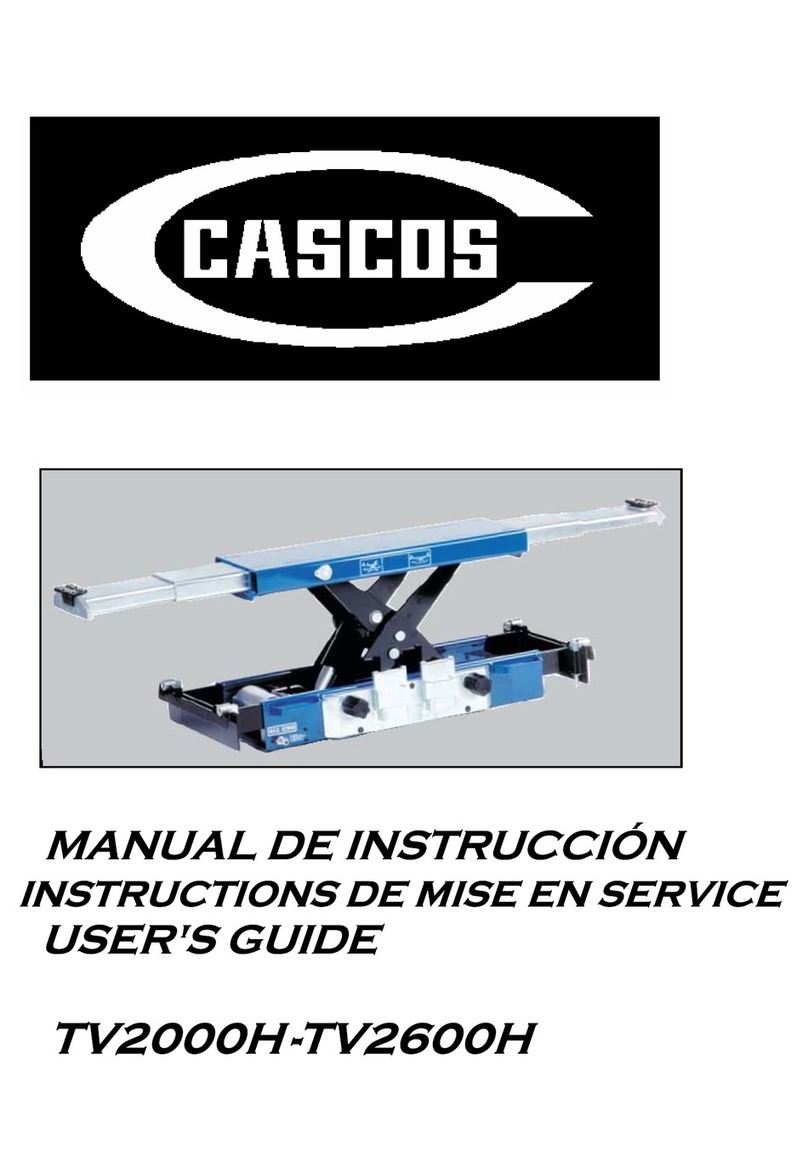
CASCOS
CASCOS TV2000H user guide
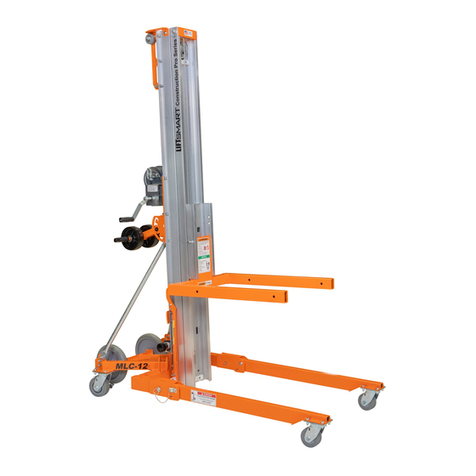
LiftSmart
LiftSmart MLM Mini-Pro Series Operator's manual

Harbor Freight Tools
Harbor Freight Tools PITTSBURGH 56617 Owner's manual & safety instructions

HIAB
HIAB Hooklift Multilift XR S Series User and maintenance manual
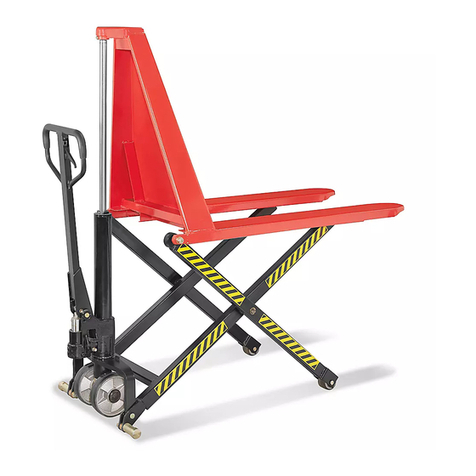
U-Line
U-Line H-5441 quick start guide
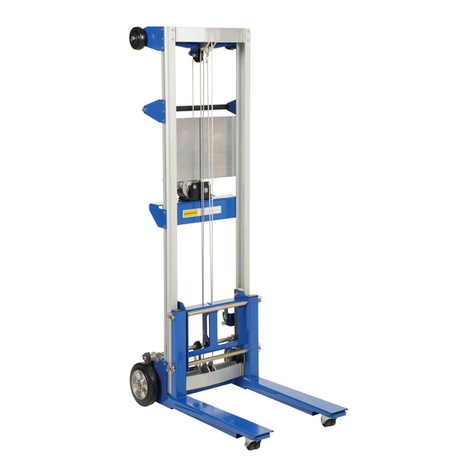
Vestil
Vestil A-LIFT-R instruction manual
